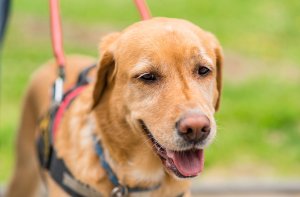
The ADA defines service animals as dogs that are individually trained to do work or perform tasks for people with disabilities. Examples of such work or tasks include guiding people who are blind, alerting people who are deaf, pulling a wheelchair, alerting and protecting a person who is having a seizure, reminding a person with mental illness to take prescribed medications, calming a person with Post Traumatic Stress Disorder (PTSD) during an anxiety attack, or performing other duties. Service animals are working animals, not pets. The work or task a dog has been trained to provide must be directly related to the person’s disability, regardless of whether they have been licensed or certified by a state or local government.
Service animals are permitted to accompany the individual with a disability to all areas of campus where members of the public are permitted except where prohibited due to health, environmental, or safety hazards (e.g. certain laboratories, mechanical rooms, areas where protective clothing is necessary, or areas where there is a danger to the animal).
For more information see: https://www.ada.gov/resources/service-animals-2010-requirements/#how-service-animal-is-defined
-Individuals with disabilities who are seeking to use a service animal are encouraged to notify Accessibility Services. The handler will be asked to complete a voluntary Service Animal Registration Form. Completed Service Animal Registration Forms shall be kept by Accessibility Services, separate from all other records held by RVCC. If the animal qualifies as a service animal, the handler must comply with this policy at all times while the animal is on RVCC property.
-If it is not obvious what service the animal provides, it is not permissible to ask about the person’s disability, request documentation, or a demonstration of the work the animal can perform. Permissible inquiries are limited to:
1) Is the animal a service animal?
2) What work or task is the dog trained to perform?
-Members of the campus community shall avoid:
-Petting, feeding, or distracting the animal. Remember, it is a working animal.
– To assist the campus community in identifying the animal as a service animal, the service animal should wear a harness or other gear that identifies it as a working animal.
-The service animal must have an owner identification tag, current license and tags from local authorities.
– Service animals must be properly immunized and vaccinated.
-The handler is financially responsible for any damage the service animal causes including bodily injury and property damage beyond reasonable wear and tear.
–Service animals must be harnessed, leashed, or tethered, unless these devices interfere with the service animal’s work or the individual’s disability prevents using these devices. In that case, the individual must maintain control of the animal through voice, signal, or other effective controls at all times.
-The service animal must be housebroken. The handler is responsible for all clean up and waste disposal. Animal waste must be immediately picked up by the owner, placed in a plastic bag, securely tied, and disposed of in an outside trash dumpster.
-The school is not responsible for any harm to a service animal while on campus, including but not limited to injury to the animal caused by pest management or lawn care products.
-The animal may not be allowed on campus, regardless of training or certification
-When the animal’s behavior poses a direct threat to the health or safety of others
-Exhibits behavior that interferes with the educational process
-Behaves in an unacceptable way and the handler does not control the animal
-Is not housebroken, licensed, or properly vaccinated
-If the animal is excluded from the property, RVCC shall still afford the individual with a disability the opportunity to participate in its programs or activity without having the service animal on the premises.
Service animals are not permitted in laboratories:
- Utilizing risk group 2 or higher biological materials
- Using radioactive materials
- Requiring protective clothing (sterile facilities or containing hazardous pathogens)
- If the animal is trained to pick up items or alert the user and materials used in the lab could be harmful
Laboratory classrooms where the service animal is permitted may still require appropriate protective equipment i.e. dog goggles, booties, or a mat to lie on. Further, service animals can be excluded from laboratory classrooms when the animal’s behavior poses a direct threat to the health or safety of others, exhibits behavior that interferes with the educational process, or behaves in an unacceptable way given the environment and the handler does not control the animal.
Service animals permitted in a laboratory classroom should be placed out of the way of hazards, should not create an obstacle to other students, and should allow the service animal to keep the student in their line of sight. Possible locations must be discussed with the handler first and may include a location at the end of a bench, in a corner, under a lab bench, under a table, against the wall and/or under a coat rack.
Please discuss the nature of any lab sciences you may be enrolled in with your instructor in order to determine if the lab is a safe environment for the service animal.
